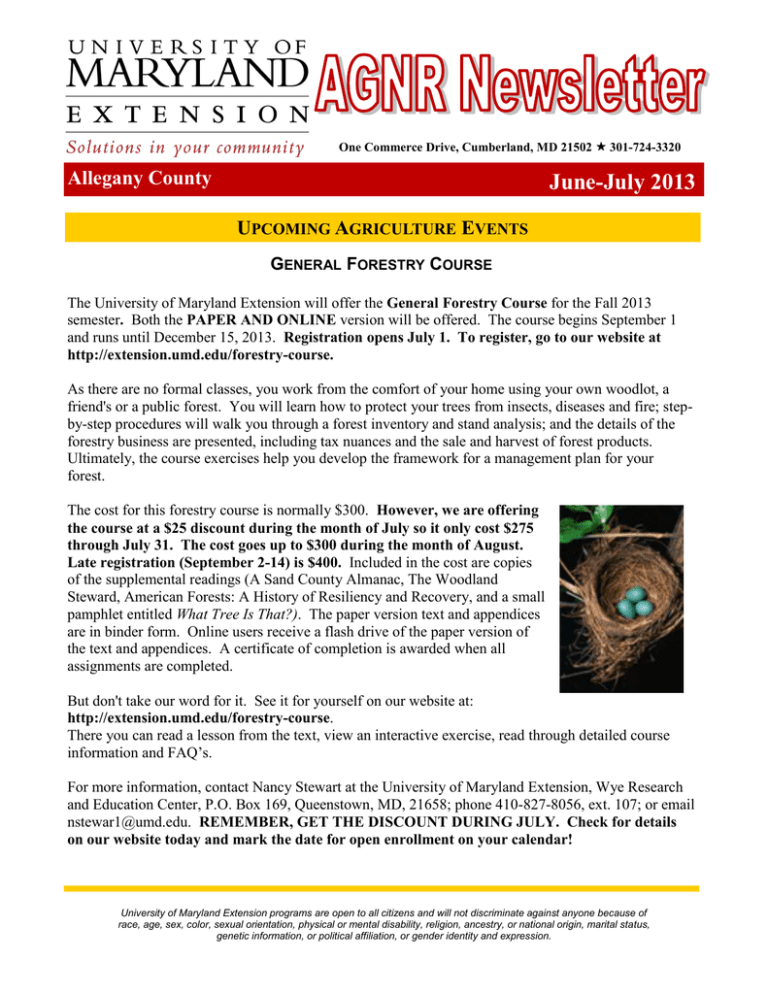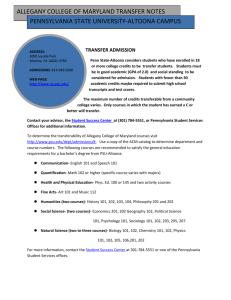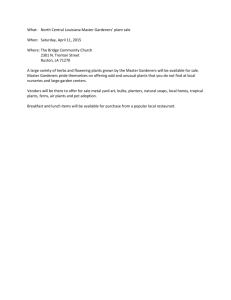June-July 2013 Allegany County U A
advertisement

One Commerce Drive, Cumberland, MD 21502 301-724-3320 Allegany County June-July 2013 UPCOMING AGRICULTURE EVENTS GENERAL FORESTRY COURSE The University of Maryland Extension will offer the General Forestry Course for the Fall 2013 semester. Both the PAPER AND ONLINE version will be offered. The course begins September 1 and runs until December 15, 2013. Registration opens July 1. To register, go to our website at http://extension.umd.edu/forestry-course. As there are no formal classes, you work from the comfort of your home using your own woodlot, a friend's or a public forest. You will learn how to protect your trees from insects, diseases and fire; stepby-step procedures will walk you through a forest inventory and stand analysis; and the details of the forestry business are presented, including tax nuances and the sale and harvest of forest products. Ultimately, the course exercises help you develop the framework for a management plan for your forest. The cost for this forestry course is normally $300. However, we are offering the course at a $25 discount during the month of July so it only cost $275 through July 31. The cost goes up to $300 during the month of August. Late registration (September 2-14) is $400. Included in the cost are copies of the supplemental readings (A Sand County Almanac, The Woodland Steward, American Forests: A History of Resiliency and Recovery, and a small pamphlet entitled What Tree Is That?). The paper version text and appendices are in binder form. Online users receive a flash drive of the paper version of the text and appendices. A certificate of completion is awarded when all assignments are completed. But don't take our word for it. See it for yourself on our website at: http://extension.umd.edu/forestry-course. There you can read a lesson from the text, view an interactive exercise, read through detailed course information and FAQ’s. For more information, contact Nancy Stewart at the University of Maryland Extension, Wye Research and Education Center, P.O. Box 169, Queenstown, MD, 21658; phone 410-827-8056, ext. 107; or email nstewar1@umd.edu. REMEMBER, GET THE DISCOUNT DURING JULY. Check for details on our website today and mark the date for open enrollment on your calendar! University of Maryland Extension programs are open to all citizens and will not discriminate against anyone because of race, age, sex, color, sexual orientation, physical or mental disability, religion, ancestry, or national origin, marital status, genetic information, or political affiliation, or gender identity and expression. NUTRIENT MANAGEMENT NEWS The Pre-side dress Soil Nitrate Test (PSNT) is a widely used test for optimizing nitrogen fertilizer use for corn grain and corn silage. This is an optional soil test that measures the amount of nitrate nitrogen available in the soil at the time when the crop is most likely to start using it. This nitrogen is a by-product of the mineralization of manure and/or last year's forage legume crop, and its availability is influenced by soil temperature and moisture. The PSNT should be run when corn is between 6 and 12 inches tall. This is the time period when corn is getting ready for a rapid growth spurt and will require nitrogen to fuel this growth. If the PSNT shows enough nitrogen is present in the soil, it may be beneficial to forego the application, thus saving time and money. If the test shows nitrogen is low, it may be beneficial to consider side dressing additional nitrogen to avoid any potential compromise in yield. PSNT is applicable on fields where: Corn for silage or grain is being grown Manure or biosolids have been applied this year or in the past two (2) years A forage legume was grown last year Less than 50 pounds of commercial fertilizer nitrogen per acre were applied prior to side dress PSNT is not applicable on fields where: More than 50 pounds of commercial fertilizer nitrogen per acre have been applied prior to side dress Commercial fertilizer has historically been the only nutrient source Irrigation is used If you are interested in conducting a PSNT on your farm in Allegany County, contact Helena Lewis, Nutrient Management Advisor at 301-724-3320. Source: University of Maryland’s Agricultural Nutrient Management Program Website SOIL CONSERVATION NEWS Effective January 1, 2014 New Nutrient Management Regulations will be put into effect for the State of Maryland by the Maryland Department of Agriculture (MDA). Key changes include incorporation of manure, nutrient applications setbacks and fencing livestock out of streams. Cooperators need to become familiar with these regulations due to the impacts they will impose on their farming operations. Allegany Soil Conservation District or Allegany Extension Office can be contacted to provide additional information for the New Nutrient Management Regulations. The Allegany Soil Conservation District is not a compliance or regulatory agency. We are strictly a voluntary organization. We are available to offer technical service at any time and offer financial assistance through State and Federal funded programs, to help Cooperators meet the New Nutrient Management Regulations. Please do not hesitate to contact us if you have any questions or comments. The Soil Conservation District’s sole purpose is to work with producers and/or landowners to preserve and improve soil and water quality in Allegany County. Sincerely, Adam T. Heavner District Manager Wilbert R. Paul Conservation Building 12407 Naves Cross Road, NE Cumberland, Maryland 21502 Phone: 301-777-1747, Ext. 101 Fax: 301-777-7632 aheavner@atlanticbbn.net Maryland Potato Late Blight Advisory May 28, 2013 Kathryne Everts, University of Maryland Late blight forecasts are being generated for eight locations across the state based on the programs Blightcast and Simcast. A preventative late blight fungicide application such as mancozeb or chlorothalonil is recommended once 18 Disease Severity Values (DSVs) accumulate from 50% crop emergence. A 50% emergence date of May 1 was estimated for Dorchester Co., Clinton, Owings, Severn, Mechanicsville, and White Marsh. A 50% emergence date of May 5 was estimated for Germantown, and May 10 for Oakland. All locations have reached the threshold for the initial fungicide spray. If no protectant has been applied, one should be applied now. Once the first fungicide is applied, subsequent late blight sprays are based on the Simcast program. This program requires information on specific fungicide applications in a field. Therefore, I am reporting the Simcast spray interval as a guideline only. It is based on the assumption that a susceptible cultivar is being grown and that a protectant such as chlorothalonil is being applied whenever DSV’s indicate that another application is warranted. Currently there are no confirmed reports of late blight on either tomato or potato outside of Florida. However, there is one unconfirmed report of a tomato greenhouse outbreak in Berkeley Springs, West Virginia. The potato crop should continue to be protected with a preventative application of mancozeb or chlorothalonil. In addition, tomatoes in the proximity of the potential outbreak area should also be protected. Growers in the area near Berkeley Springs should increase the scouting frequency of fields. Late Blight Disease Severity Value (DSV) Report Simcast spray interval Location DSV recommendation* Dorchester County 29 7-day Germantown 37 5-day Clinton 37 5-day Owings 31 10-day Severn 37 5-day White Marsh 20 8-day Mechanicsville 31 10-day Oakland 14 10-day * Spray interval recommendation is based on production of a susceptible cultivar and application of a protectant fungicide such as chlorothalonil. Growers opting not to use the forecast system should put the first late blight fungicide application on when the plants are 6 inches tall, and repeat every 7 days. There are numerous fungicides now labeled for late blight control. See the 2013 Commercial Vegetable Production Recommendations, Maryland http://extension.umd.edu/mdvegetables/2013-commercialvegetable-production-recommendations. SUPPORT LOCAL PRODUCERS BY VISITING FARMERS MARKETS Farmers markets are a great way for local producers to share their products with the public. It is also a great way for consumers to meet the local individual who is producing their food as well as to support their local economy. This year, all produce at the markets, flowers etc. are growers only, which means that everything had to be grown on the farm that is selling the product. There will be lots of flowers and mostly greens and strawberries for the first market. Green onions, lettuce, radishes, maybe some beets, and new potatoes will be available in the first month of the markets. Downtown Mall will begin on Thursday May 30th from 9:30am-2pm through Oct 10 Master Gardeners will be hosting plant clinics in conjunction with this market the second Thursday of the month 9am-12pm. June 13, July 11, August 8, Sept 12, Oct 10. Frostburg on Market street at City place will begin on Friday June 1 from 9:30am-1pm through Oct 11 Saturday at Canal Place will begin on June 8 from 9:30am- 2pm through Oct 12 Tuesday at Country Club Mall will begin on June 4 from 9:30am-2pm through Oct 15 A Wednesday market at the hospital will begin after the 4th of July from 2-5pm. MASTER GARDENER EVENTS AND HAPPENINGS Master Gardeners in Allegany County have been very busy over the last month with numerous events and activities! Allegany County Master Gardeners recently hosted their 1st Annual Open House and Plant Sale on May 4, 2013. Master Gardener Volunteers hosted the event at their Demonstration Garden, which is housed on site at the University of Maryland Extension office in Allegany County. Composting demonstrations, container gardening education and youth scavenger hunts were some of the educational activities held in conjunction with the plant sale. UME staff also provided information about the various programs offered in the county including, Agriculture, 4-H, FSNE and EFNEP. Visitors were given tours of the demonstration garden and greeted with smoothies provided by the FSNE and EFNEP programs. All and all the event was a major success and the Master Gardeners look forward to hosting this annual event in the years to come. After completing their basic training course, Master Gardener Trainees participated in an entire day of local farm tours on May 11th, 2013 in and around Allegany County. The Farms visited included Goodness Grows, owned by Rob and Dawn Custer, Walnut Ridge Farm and Greenhouse owned by Jeanette Rinehart, and MacFarlane Lantern, owned by Solomon Rose. Master Gardeners learned about sustainable agriculture, organic vegetable production, livestock systems and hops production. To wrap up the month of May, 7 Allegany County Master Gardeners traveled to College Park, with Garrett and Washington County Master Gardeners for the State Master Gardener Annual training day on May 22, 2013. This event was attended by nearly 800 master gardeners from across the state and Washington D.C. Our local Master Gardeners spent the entire day listening and learning from keynote speakers, breakout sessions and university professionals about anything and everything related to gardening and home horticulture. For the remainder of the spring season Master Gardeners will be offering plant clinics for the public on June 13 at the Downtown Farmers Market, and on June 22 at Lowes in LaVale. MASTER GARDENERS UPCOMING DATES TO REMEMBER Lowes Plant Clinic– Saturday, June 22, 2013 10 a.m. to 2 p.m. Volunteers are needed please contact Becky at 301-724-3320 or byost1@umd.edu if you are interested in helping. Farmers Market Plant Clinics– Downtown Cumberland, second Thursday of the month from 9 a.m. to 12 p.m.—June 13, July 11, August 8, September 12, October 10. June 20, 2013– Master Gardener Meeting 4 to 6 p.m. United Methodist Church on North Centre Street July 15 to 20, 2013– Allegany County Fair. Master Gardeners are needed to work the educational booth in the Multipurpose Building. July 15, 2013–Quarterly reports are due to the Extension Office. This should be the volunteer and educational hours logged for the months of April, May and June of 2013. October 15, 2013–Quarterly reports are due to the extension office. This should be the volunteer and educational hours logged for the months of July, August and September of 2013. Facebook Page—The Master Gardeners are pleased to announce that we now have a facebook page! Search for Allegany County Master Gardeners and like our page! Or type the link into your address bar: http://www.facebook.com/AlleganyCountyMasterGardeners Also feel free to share and invite your friends! My hopes are that this page will not only be a way that we can communicate with each other, but a way to share information about upcoming events, activities and education with the public! WEED IDENTIFICATION Recently I have received calls about a common pasture/field weed called Bedstraw, so I decided to share a little bit of information about this weed. Description: Smooth Bedstraw is a perennial with numerous upright stems and a whorled-leaf arrangement. It produces white to green flowers in June and July. Habitat: Appears in mowed hayfields with low soil fertility and pH but is very adaptive and can survive in a wide variety of environments. It will tolerate drought and will grow in almost any soil type. Reproduction: This plant spreads by many seeds which stay viable for about a year. It will also spread from rhizomes once the plant has been established. Control Methods: A combination of methods tends to be the most successful. Some methods include raising soil pH with lime and supplying forage land with adequate nutrients to provide better growing conditions for your forage crops. Hopefully these forage grasses will then outcompete the bedstraw. Mowing more than once a year will keep forage grasses active and will help to prevent some of the weeds from going to seed. Mowing, however, will not eliminate bedstraw due to the rhizomes in the soil but can keep it from spreading. In severe infestations, fields should be plowed and replanted with a field crop or cover crop for at least two years. This will prevent seed storage from germinating as sunlight will be inhibited by the field/cover crop. Chemical herbicides such as 2-4-D, Dicamba, and Glyphosate can be used, but need to be used often to be effective due to the energy reserves in the soil. These herbicides will also kill other grasses, clovers and legumes in the field. For more detailed information about Bedstraw check out some of the factsheets below http://extension.unh.edu/resources/representation/Resource000032_Rep32.pdf http://www.gnb.ca/0170/Smooth%20Bedstraw.pdf http://extension.umass.edu/landscape/weeds/galium-mollugo UNIVERSITY OF MARYLAND EXTENSION Allegany County Office One Commerce Drive Cumberland, Maryland 21502 NONPROFIT ORG U.S. POSTAGE PAID CUMBERLAND, MD PERMIT NO. 932 IN THIS ISSUE: Upcoming Agriculture Events Nutrient Management news Soil Conservation news Farmers Markets Open! Master Gardener News and Events Weed Identification Save Paper! To receive this newsletter by email, send a note to: jparrish@umd.edu.


